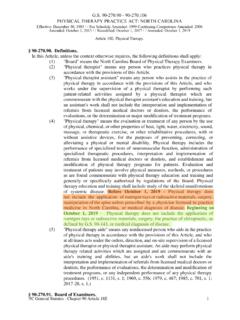Transcription of PHYSICAL THERAPY - Batten Disease Support & Research ...
1 PHYSICAL THERAPY 2 WELCOME NOTICE TO THE READER This Batten Disease Handbook is complied with information from many sources concerning the topics included. Families in the organization have also contributed their specific situations that have been helpful in their own battle with Batten Disease . All material in this book is provided for information purposes only. Although Batten Disease Support and Research Association (BDSRA) has made every reasonable effort to assure the accuracy of the information contained in this book, BDSRA is not engaged in rendering medical or other professional services and advice. BDSRA does not guarantee or warrant that the information in the book is complete, correct, current, or applicable to every situation.
2 BDSRA disclaims all warranties express or implied, concerning this book and the information contained herein. If medical or other expert assistance is required, the services of a competent professional should be attained. Nancy Carney, RN Batten Disease Support and Research 2004 3 PHYSICAL THERAPY MOTOR DEVELOPMENTAND RELATED TOPICS OUTLINE Cover Page Page 1 Welcome Page Page 2 Outline Pages 3-8 I. PHYSICAL THERAPY Pages 9-25 A. What is PHYSICAL THERAPY ? Page 9 B. What is the purpose of PHYSICAL THERAPY ? Page 11 C. Who are PHYSICAL Therapists? Page 11 D. What does the PHYSICAL therapist do?
3 Page 11 1. Examination of your child Page 16 2. Alleviating impairment and functional limitation Page 18 3. Minimizing injury, impairment, functional limitation and/or any other special needs Page 19 4. Steps of treatments Page 19 5. Engaging in consultation, education and Research Page 20 E. Where do PHYSICAL Therapists work? Page 21 F. Is PHYSICAL THERAPY painful? Page 22 G. How long does a THERAPY session last? Page 22 H. PHYSICAL THERAPY Assistants Page 23 I. Occupational Therapists Page 23 1. Questions to ask an Occupational therapist Page 24 J.
4 Certified Occupational THERAPY Assistants Page 25 II. PHYSICAL THERAPY Early Intervention Pages 25-30 A. Guidelines for Referral Page 25 1. Referrals Page 25 2. The PHYSICAL therapist consults Page 26 3. The PHYSICAL therapist in different areas of service Page 27 a. In pediatrics Page 27 b. In the school setting Page 27 1. The practice of determining eligibility Page 27 4 2. Special education as a process Page 28 3. In evaluating programs Page 28 4. All schools are required by federal law Page 29 5.
5 Role of PHYSICAL and Occupational Therapists in school settings Page 30 B. Educational Issues Pages 30-34 1. Areas of child care taught by PHYSICAL Therapists Page 30 2. Methods or tools of child education used in clinical practice Page 31 3. Importance of PHYSICAL Therapists behaviors related to the child/parent teaching Page 31 4. Techniques used to assess effectiveness in teaching skills Page 32 5. Barriers to delivering education Page 32 6. Interactional behaviors that facilitate or impede the therapist s ability to connect with the child/parents Page 33 a.
6 Verbal b. Non-verbal 7. Preparation for effective teaching and learning Page 33 8. Teaching the child and the family Page 34 C. Interventions Pages 34-47 1. Assessment and planning for Intervention Page 34 2. Differences between PHYSICAL and Occupational THERAPY approaches Page 35 3. How does Batten Disease affect our children? Page 37 4. As Batten Disease progresses Page 38 5. Tips for reducing stress for your child and for you Page 38 6. Early Intervention Programs Page 39 a. Elements of effective early Intervention programs Page 40 7.
7 How can parents/family help? Page 42 8. The role of the family in PHYSICAL THERAPY Page 43 a. Selecting the best options for your child Page 43 9. Things to consider when choosing an Intervention program Page 44 10. Services that may be included in early Intervention Programs Page 44 11. Types of Intervention Programs Page 45 12. Four types of Intervention strategies Page 45 5 13. Intervention Specialists Page 47 14. Getting the most out of Intervention Page 47 III. Families and Behavior Pages 48-65 A. Encouraging appropriate child behavior Page 48 1.
8 Some problematic behaviors and challenging skill deficits that are common among children with Batten Disease Page 48 2. When behavior puts your child or others in danger of injury Page 48 3. Several things to keep in mind Page 49 B. Parent reactions and adaptations to having a child with special needs Page 50 C. What do we tell our parents? (child s Grandparents) Page 56 D. Effects on siblings Page 56 E. How will other family members and friends react? Page 60 F. Effects on our child with special needs Page 61 1.
9 Experiencing an illness Page 61 2. Classmates and friends Page 62 3. The philosophy of inclusion Page 62 4. Adolescence Page 63 G. Some additional suggestions for parents that may be helpful Page 63 H. Providing health care services Page 64 IV. Body mechanics for parents and care givers Pages 65-78 A. Practicing good body alignment and movement Page 65 B. Pictures Pages 66-77 V. Medical Issues Pages 78-110 A. Your child s level of independence and function Page 78 1. Exercise Page 79 2. Diet Page 79 3. Skin care Page 81 4.
10 Prevent osteoporosis Page 81 5. Bowel and bladder management Page 81 B. Immobility Page 81 C. Bone healing Page 82 6 D. Complications of immobility skeletal issues Page 85 1. Spasticity Page 85 2. Contractures Page 87 3. Osteoporosis Page 89 4. Spinal Deformities Page 90 a. Scoliosis Page 91 5. Pressure Sores Page 92 a. Contributing factors to pressure sores Page 93 b. The stages of pressure sores Page 93 c. The treatment of established pressure sores Page 96 d.






